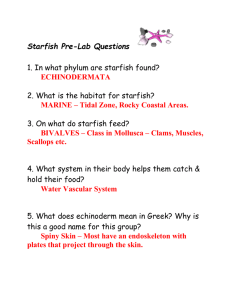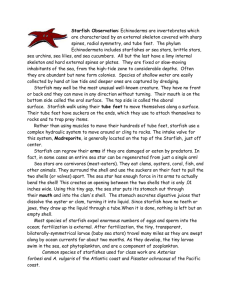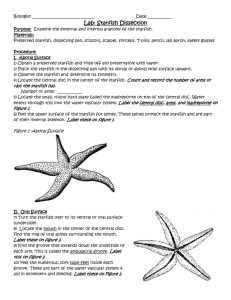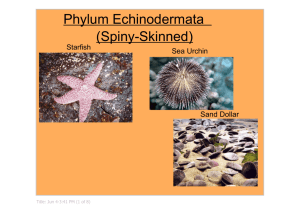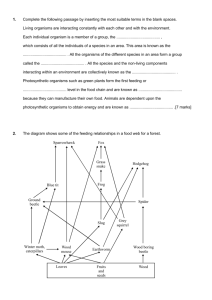Dissecting an Echinoderm – The STARFISH
advertisement
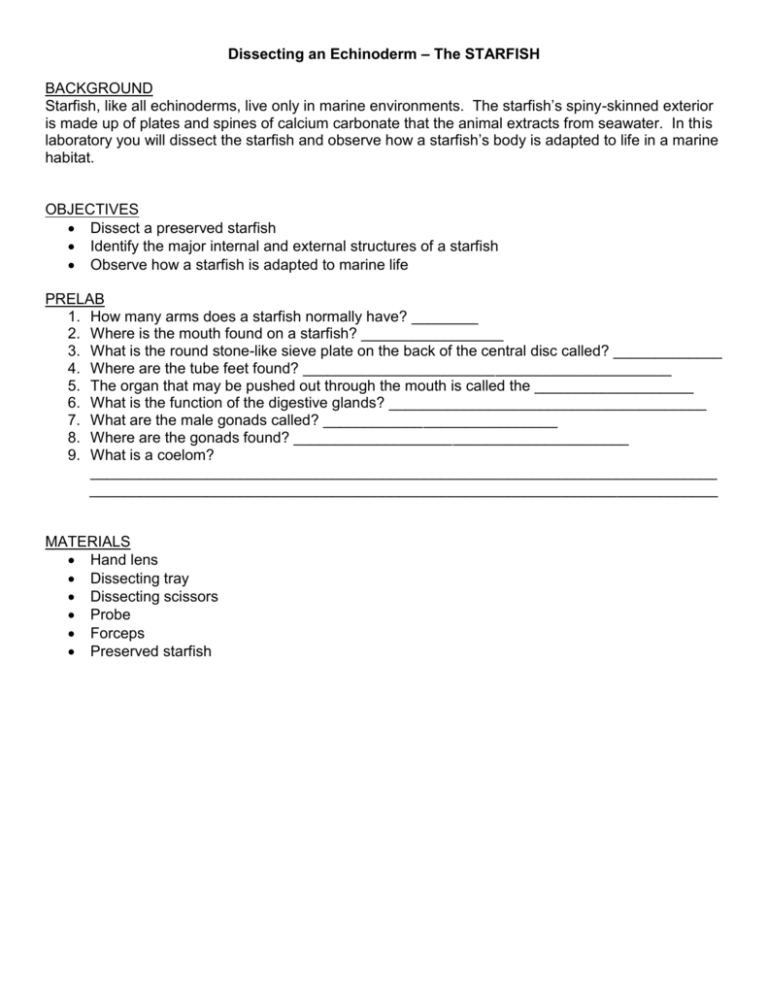
Dissecting an Echinoderm – The STARFISH BACKGROUND Starfish, like all echinoderms, live only in marine environments. The starfish’s spiny-skinned exterior is made up of plates and spines of calcium carbonate that the animal extracts from seawater. In this laboratory you will dissect the starfish and observe how a starfish’s body is adapted to life in a marine habitat. OBJECTIVES Dissect a preserved starfish Identify the major internal and external structures of a starfish Observe how a starfish is adapted to marine life PRELAB 1. How many arms does a starfish normally have? ________ 2. Where is the mouth found on a starfish? _________________ 3. What is the round stone-like sieve plate on the back of the central disc called? _____________ 4. Where are the tube feet found? ____________________________________________ 5. The organ that may be pushed out through the mouth is called the ___________________ 6. What is the function of the digestive glands? ______________________________________ 7. What are the male gonads called? ____________________________ 8. Where are the gonads found? ________________________________________ 9. What is a coelom? ___________________________________________________________________________ ___________________________________________________________________________ MATERIALS Hand lens Dissecting tray Dissecting scissors Probe Forceps Preserved starfish PROCEDURE A: THE STARFISH’S EXTERNAL ANATOMY o Obtain all the materials listed for this dissection and place them in your work area. o Place the starfish on your dissecting tray. o Locate the dorsal (top) and ventral (bottom) parts of the starfish. o Use the information in the Table A and Figure 1 below to identify the external anatomy of the preserved starfish. Figure 1. Dorsal and Ventral Surfaces of a Starfish Table A.: The External parts of a Starfish DORSAL SURFACE VENTRAL SURFACE Arm – one of the usually five rays Ambulacral groove – trench running through the center of each ray Disc – central raised portion from which arms Eye* – red spot at the tip of each ray radiate Madreporite – small, stone-like, sieve plate on Mouth – opening in center of disc surrounded by the disc found toward the edge of the central protective spines disc. Anus* - small opening on disc opposite the Tube feet – rows of feet along the groove of each madreporite arm. They are part of the water vascular system and help to hold objects using a suction type of process. Each tube foot has a suction disc on the end. Gills* - delicate projections of tissues Spine – hard, blunt projection rising through skin from platelike skeleton Pedicellaria – tiny pincers *May be difficult to observe on a preserved starfish. Use a hand lens if needed. PROCEDURE B: INTERNAL ANATOMY OF THE STARFISH o Place the starfish dorsal side up in the dissecting tray. o Locate the madroporite. o Cut off the tip of an arm that is next to the madroporite. o Cut the upper side of one arm and the disc stopping just short of the madreporite as shown in the diagram c. o Start at the tip of the arm and peel and tease away the flap you just cut free. o Using Figure 3 and Table 2, locate the pyloric seca. o Carefully remove all the pyloric seca from your starfish and place on dissecting tray. o Using Figure 3 and Table 2, locate the radial canal and cardiac stomach o Using Figure 3 and Table 2, locate the gonads. If the gonads are embedded on either side of the radial canal, use the probe to gently lift them out. Figure 2. How to Begin Dissecting the Starfish Figure 3. The Internal Structures of a Starfish Table B.: The Internal parts of a Starfish Pyloric ceca- large digestive glands inside the Gonads – in the arm, the male has testes, the stomach that extend through the mouth. They female has ovaries. The gonads of both sexes are the top, brown colored structures. look very much alike, making it difficult to determine the sex of a starfish. The male testes are usually grey and the females ovaries are usually orange. The gonads might be embedded on either side of the radial canal. Cardiac Stomach- during feeding the cardiac Radial canal- is located on top of the ambulacral stomach comes out of the mouth and floods the groove and distributes water through the arm. prey with enzymes from the digestive glands. Ampullas- connects with a tube foot that passes through the body and projects from the ambulacral groove on the ventral side of the body DIGESTIVE SYSTEM. Large digestive glands also called the pyloric ceca are inside the arm. The digestive glands supply digestive juices to the stomach. Sometimes part of the stomach extends through the mouth. The ducts of each gland join at the base of the arm to form the pyloric duct that enters the pyloric stomach. The mouth and short esophagus lead directly to the starfish’s two stomachs: the cardiac stomach and the pyloric stomach. From the stomach, a short narrow intestine leads to the anus. During feeding the cardiac stomach comes out of the mouth and floods the prey with enzymes from the digestive glands. REPRODUCTIVE SYSTEM. A starfish is either male or female. If the starfish was collected during breeding season the arms will be filled with gonads. The gonads of the male and female starfish look similar. WATER VASCULAR SYSTEM. Seawater enters this system through the madreporite that connects through a stone canal with the ring canal. A radial canal, located on top of the ambulacral groove distributes water through the arm. Connecting canals pass outward from the radial canal to the bulb-like ampullas. Each ampulla connects with a tube foot that passes through the body and projects from the ambulacral groove on the ventral side of the body. The starfish moves and exerts force through the use of suction at the end of the tube feet. PROCEDURE C: CLEAN UP Dispose of your dissected starfish in the manner described by your teacher. Clean up your work area and wash your equipment after you have completed the dissection. ANALYSIS 1. List two adaptations of the starfish that suit it well to its life in shallow, marine waters. ___________________________________________________________________________ ___________________________________________________________________________ ___________________________________________________________________________ 2. How does the skelton of a starfish differ from your skeleton? ___________________________________________________________________________ ___________________________________________________________________________ ___________________________________________________________________________ 3. Name three traits of the starfish that place it in the phylum Echinodermata. ___________________________________________________________________________ ___________________________________________________________________________ ___________________________________________________________________________




